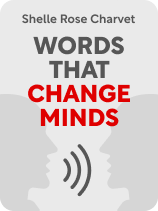

This article is an excerpt from the Shortform book guide to "Words That Change Minds" by Shelle Rose Charvet. Shortform has the world's best summaries and analyses of books you should be reading.
Like this article? Sign up for a free trial here.
What does it take to convince you of something? How in touch are you with what it takes to persuade the people around you?
Influencing language expert Shelle Rose Charvet contends that everyone has a persuasion style. She identifies four persuasion styles and provides advice on how you can detect a person’s style and communicate with them in a way that hits the mark. She also addresses the amount of evidence people require.
Read more to understand Charvet’s arguments and to get some analysis on both persuasion styles and requirements.
Persuasion Style
Charvet uses the term “Convincer Channel” to refer to the kind of evidence people need to encounter before changing their minds about something. Someone’s preference for one form of evidence is their persuasion style.
Charvet asserts that everybody has one of four persuasion styles: They find visual evidence, auditory evidence, written evidence, or experiential evidence the most persuasive. You can discern which persuasion style someone has by asking them how they came to a certain conclusion; for instance, you could ask how they determined that their current job was right for them. The evidence they used to reach their answer will correspond with one of the four persuasion styles.
To get someone to come to a certain conclusion after you’ve discerned their persuasion style, present them with their preferred form of evidence. For example, if you want to persuade someone that your restaurant is successful so they give you a loan for expansion, you can show them charts of your profits as visual evidence, practice a compelling business pitch as auditory evidence, show them customer reviews as written evidence, or let them taste your food as experiential evidence.
| Counterpoint: Are Persuasion Styles a Myth? The idea that different people optimally absorb information in one of four different ways is also popular in the field of education. Since 1992, many educators have been taught to tailor their curricula for students with all four learning styles: visual learners, auditory learners, reading and writing learners, and kinesthetic learners (learning through direct experience). This set of four styles is known as the “VARK model.” However, recent research indicates that presenting students with information matching their learning style doesn’t help them understand the information any better. Although students often prefer one form of learning over another, this preference doesn’t improve their learning results. Since people have to learn about and understand the evidence you give them to be convinced, it’s possible that Charvet’s model of four persuasion styles is equally invalid. Instead of spending the effort identifying and catering to someone’s persuasion style, you may be better off relying on tried-and-true persuasion methods that work for everyone. For example, the “foot-in-the-door” tactic takes advantage of a universal weakness of human psychology: the drive to behave consistently. If you can influence someone to make a small commitment, they’re significantly more likely to make a larger commitment later on to keep their decision-making logic consistent. For instance, getting someone to post on social media about your nonprofit makes them more likely to make a donation in the future. |
Persuasion Requirements
Charvet also addresses persuasion requirements. Rather than focusing on the kind of evidence that people need, this is about the amount of evidence (or time to consider evidence) that people need to change their minds. Charvet calls this the “Convincer Mode” category.
You can identify someone’s persuasion requirements by posing a hypothetical situation and directly asking them how many times they would need to encounter evidence before coming to a conclusion about that situation. For instance, you could say, “If you were looking to partner with a marketing agency, how many times would you have to meet with them before making a deal?” Even if they don’t give an exact number, their answer will reveal their persuasion requirements.
To influence someone, fulfill their persuasion requirements—give them the amount of evidence or time they need to change their mind.
| Counterpoint: Persuasion Requirements Are Flexible Some psychology research suggests that persuasion requirements are less dependent on an individual’s personality than on the way evidence is presented. For instance, the well-documented confirmation bias indicates that people generally have minimal requirements for conclusions that seem to align with what they already believe or want to be true, and they have strict requirements for conclusions that contradict their beliefs or identities. Similarly, research shows that everyone may have both quantity-based requirements and time-based requirements, as long as you present evidence enough times over a long enough timeframe. The illusory truth effect describes how any evidence becomes more convincing if you encounter it enough times. This is because the evidence we encounter multiple times is easier to recall, and our brains falsely conclude that ideas that are easy to recall are more likely to be true. We’re also susceptible to the spacing effect: Information is easier to recall if we learn it over a longer timeframe. This means that all evidence becomes more convincing if you present it over time. Thus, rather than investing effort in identifying and fulfilling someone’s persuasion requirements, you may find more success by fulfilling all persuasion requirements as much as possible. Frame your evidence so it aligns with your target’s existing beliefs as much as possible, and be persistent in presenting as much evidence as you can over as long a timeframe as possible. |

———End of Preview———
Like what you just read? Read the rest of the world's best book summary and analysis of Shelle Rose Charvet's "Words That Change Minds" at Shortform.
Here's what you'll find in our full Words That Change Minds summary:
- Why it's sometimes hard to understand what others are trying to say
- The 14 kinds of mental habits that explain how people think
- How to understand others better and build positive relationships






